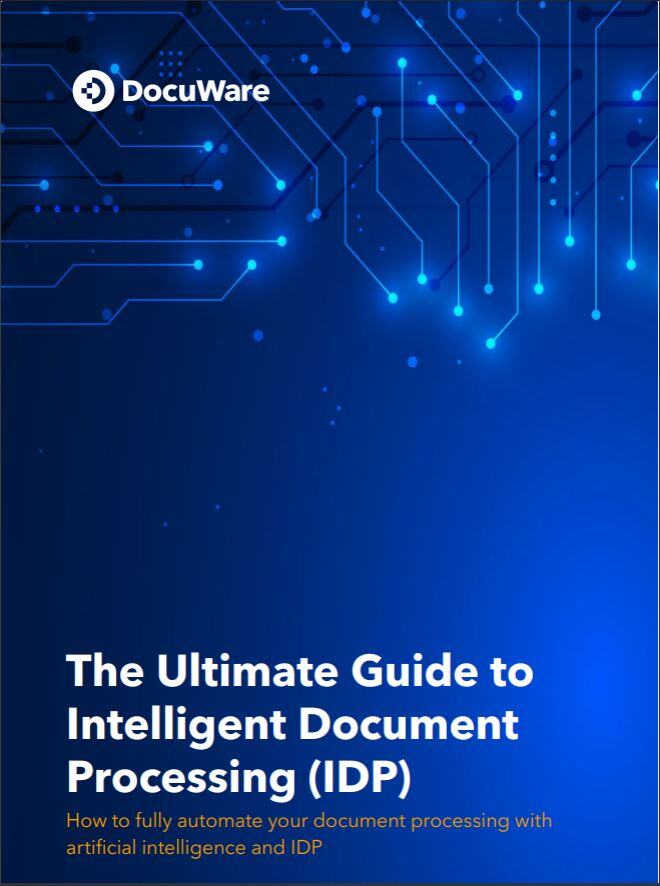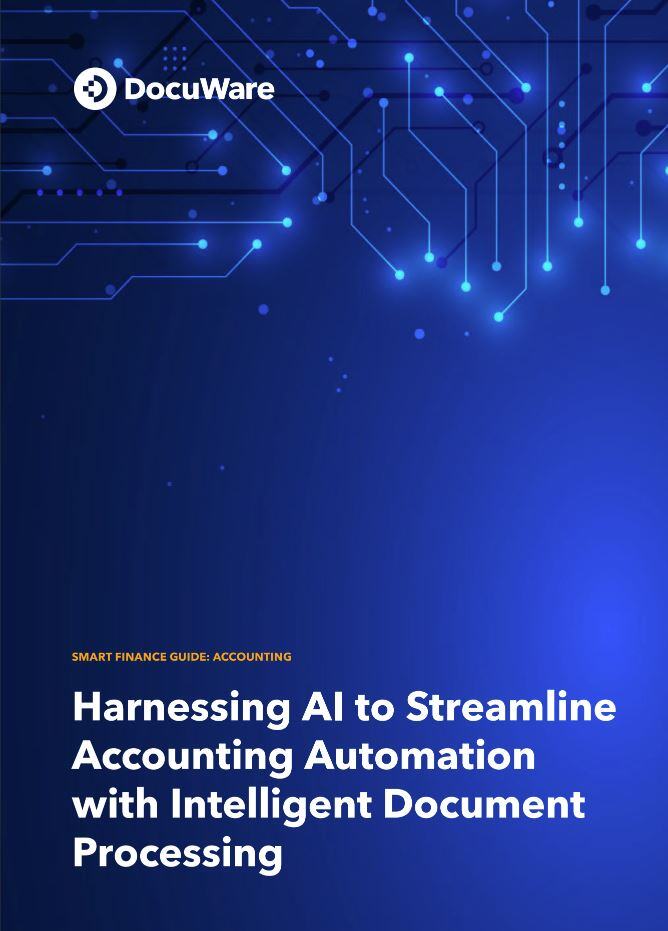
The Ultimate Guide to Intelligent Document Processing
Discover how DocuWare's IDP can streamline your business processes and increase efficiency with advanced automation technology.
Your operational teams didn't sign up to be data entry clerks, yet that's exactly what many of them have become.
While they should be providing strategic support, they’re drowning in paperwork: invoices piling up, contracts requiring manual review, and purchase orders scattered across emails, shared drives and handwritten forms. Their day-to-day processes are tedious, slow and inefficient.
This paperwork burden is undermining your entire operation. When qualified professionals spend their time managing documents instead of adding value, the ripple effects are felt company-wide. Delayed decision making, increased compliance risks and missed growth opportunities, while talented staff question if their expertise is properly valued.
Intelligent Document Processing (IDP) is the AI-powered solution that eliminates these bottlenecks. By capturing and classifying data from your financial, HR and administrative documents, IDP automation reduces processing time by up to 80% while significantly improving accuracy.
When your staff are liberated from manual document handling, they can refocus on strategic activities that drive business growth. Data becomes more reliable, processes become more agile, and teams feel more engaged.
It's no wonder the UK government believes companies could save up to £36 billion annually by automating administrative tasks.
Intelligent Document Processing (IDP) is a technology for automatically capturing, classifying and extracting data from documents, enabling businesses to process information faster and more accurately than through manual workflows.
Unlike traditional document processing, IDP doesn't just digitise physical (print and handwritten) data. It "understands" and interprets all sorts of structured and unstructured data before filing it accordingly.
Modern IDP solutions use artificial intelligence (AI), machine learning (ML) and natural language processing (NLP) to process a variety of document types with minimal human input.
IDP automation is an ideal enhancement to your document management system (DMS), taking operational processes to the next level through intelligent data recognition and contextual understanding.
Intelligent Document Processing is powered by several key technologies that work together to transform how businesses handle documentation:
|
Modern IDP technology |
Application |
|
Computer Vision (CV) |
Computer Vision analyses the layout and structure of documents, identifying visual elements such as tables, logos, stamps and handwritten notes. It separates and categorises pages within a document, providing the spatial understanding needed to make sense of document elements. |
|
Optical Character Recognition (OCR) |
OCR technology converts printed and handwritten text into a machine-readable format. Modern OCR is AI-driven, enabling much higher accuracy rates than traditional document processing systems, even when dealing with poor quality scans or unusual fonts. |
|
Handwritten Text Recognition (HTR) |
A specialist extension of OCR, handwritten text recognition can identify and transform handwritten text into digital format. This technology has evolved significantly in recent years and is now capable of processing handwriting styles with impressive accuracy. |
|
Natural Language Processing (NLP) |
NLP enables systems to understand and interpret natural language for context-aware data capture. It recognises entities (e.g. names, invoice numbers, addresses) and can filter out irrelevant information, significantly reducing errors in document processing. |
|
Machine Learning (ML) and Deep Learning |
Adaptive ML models recognise patterns and categorise documents based on their content and structure. Neural networks stimulate human decision-making processes, and through ongoing training, these models continually enhance extraction accuracy. |
Market-leading IDP solutions use AI document processing and sophisticated workflows to convert piecemeal information into structured, actionable business data. Here’s the six-step process that DocuWare’s document management software follows to turn disparate information into digital workflows:
.jpg?width=1920&height=721&name=DW_IDP-Steps-Infographic-100%20(1).jpg)
IDP software gathers documents from multiple sources, including scanned paper documents, email attachments, PDFs, invoices, contracts and digital forms. The technology recognises and prepares information for processing, regardless of entry method. It’s compatible with multifunction printers, mobile scanners and online portals.
The system applies image enhancement techniques to scanned or low-quality documents, sharpening blurry text, correcting skewed alignments and removing visual noise. These improvements significantly enhance OCR accuracy by improving document clarity.
Next, the IDP solution extracts both structured and unstructured data using OCR, NLP and machine learning techniques. OCR converts printed or handwritten text into digital format using HTR, while NLP understands the meaning of words and phrases. This combination of technologies enables the IDP system to recognise invoice numbers, payment amounts, contract clauses and employee or customer names without requiring pre-set templates.
.jpg?width=1921&height=901&name=DW_IDP-Content-in-Out-100%20(1).jpg)
With key information extracted, IDP software uses intelligent data processing to classify documents into predefined categories such as invoices, purchase orders, HR forms and legal contracts. Machine learning improves document classification over time, automatically routing data to the right workflow or department, eliminating time previously spent on manual sorting.
IDP performs automatic validation checks on extracted data, comparing it with existing records in business systems or databases and flagging discrepancies such as mismatched invoice totals for review. This process prevents errors, reduces compliance risks and improves financial accuracy.
The validated data then seamlessly integrates with business software such as Enterprise Resource Planning (ERP) software, Customer Relationship Management (CRM) systems and Document Management Systems (DMS), automating tasks like invoice approval, contract storage and employee record updates while eliminating the need for manual data entry.
One significant application of IDP is document automation for accountants in practice. IDP technology extracts data from invoices, receipts and tax forms, reducing manual entry and errors.
The system synchronises validated data into accounting systems for real-time financial management. It also flags discrepancies, ensures tax/VAT compliance, and streamlines audit preparation with secure document storage.
Accountancy firms using IDP have reported saving up to 40 hours per week on document processing tasks. As Coen van Dinther, Finance Controller at logistics service provider, ETC Holland, notes: “We wasted a lot of time on basic administrative tasks and couldn't focus that energy on more important tasks... [now] we are rapidly accelerating our business processes and increasing efficiency in all areas of the company.”
In human resources departments, AI document processing automatically recognises and categorises CVs, cover letters and certifications based on configured logic, workflows and trained models. It can also extract key applicant data such as names, qualifications and work experience, transferring this information into applicant tracking systems.
Automatically extracting applicant data streamlines the recruitment process, reducing hiring timelines and allowing HR professionals to focus on candidate evaluation rather than paperwork. IDP technology also helps with employee onboarding, managing employment contracts and maintaining compliance with employment regulations.
German mobility service provider Stanglmeier Group used IDP software to create digital personnel files for 300 employees. It has also introduced workflows for resubmitting fixed-term employment contracts and ensuring important company notifications are securely emailed to all employees.
Even with clear benefits, many businesses still have doubts about IDP. Here are some common misconceptions that can stand in the way of IDP adoption:
|
Misconception |
Reality |
|---|---|
|
"IDP is just an advanced OCR." |
OCR extracts text, but IDP understands documents, categorises them and integrates the data into workflows. |
|
"IDP steals human jobs." |
IDP reduces repetitive tasks, allowing employees to focus on higher-value work like strategy or customer service. |
|
"IDP only works with structured data." |
Modern IDP handles both structured and unstructured documents, including invoices, contracts, emails and even handwritten letters. That's the power of AI. |
If you’re looking for further information on the advantages of IDP, DocuWare’s ultimate guide cuts through the complexity of document processing, giving you the insider knowledge to improve your operational efficiency.
Download our definitive resource and discover how to:
Automating document workflows reduces turnaround times, making them 30-50% faster than manual methods.
47% of workers struggle to find the data they're looking for. Best-in-class IDP solutions help avoid that, removing potential errors and minimising risk through accurate data extraction and validation.
IDP reduces manual data entry and error corrections, resulting in up to 32% savings. By automating repetitive tasks, companies can redirect resources to more strategic initiatives that support business growth.
IDP’s intelligent data processing capabilities ensure secure, traceable document workflows, automatically flagging inconsistencies and helping teams meet regulatory requirements. This compliance benefit is particularly valuable in industries with strict mandates, such as financial services, healthcare and legal sectors.
Half (47%) of employees feel their company is disorganised, which can lead to frustrations and inefficiencies. AI document processing frees employees from repetitive tasks, allowing them to focus on higher-value work like client service, decision-making and strategic initiatives, improving job satisfaction and reducing staff turnover.
IDP transforms slow, error-prone and costly document processing into faster, more accurate, efficient workflows. As a result, IDP solutions remove bottlenecks, improve accuracy and accelerate decision-making for businesses in a wide range of industries. For example:
Let’s take a closer look at some companies gaining value from intelligent document management.
Stuart Plumbing & Heating Supplies is a family-run business with eight branches in the UK. The firm’s rapid expansion meant its finance department was struggling to manually process over 2,000 invoices a month from many different suppliers.
By implementing DocuWare's intelligent document processing platform, Stuart Plumbing reduced its invoicing time by around 40%. DocuWare’s IDP system has also been integrated into Stuart Plumbing’s existing EDI software, enabling seamless workflow automation.
"Our key objectives when starting this project were to speed up the invoicing processing time and improve the accuracy of capture and errors,” says Stephen Elliott, Finance Director at Stuart Plumbing & Heating Supplies. “DocuWare has more than exceeded our expectations."
Glenkeir Whiskies, owner of The Whisky Shop (the largest chain of whisky stores in the UK), transformed its finance team capabilities with DocuWare IDP software.
The business previously struggled with a paper-heavy purchasing process, manually coordinating approximately 300 invoices per month. DocuWare automated email invoice processing, matching them with goods received notes using key metrics, eliminating the need for manual line-by-line checks.
According to Joe O'Raw, Glenkeir Whiskies’ Finance Manager: "Accuracy has improved immeasurably as my team no longer manually input invoice data – this reduces human errors."
Understanding the key differences between OCR vs IDP can help you make more informed decisions about your document automation strategy.
OCR provides the foundational text recognition capability for converting physical documents into digital text. But it works primarily with structured formats. IDP builds on OCR by adding cognitive understanding through AI, machine learning and natural language processing.
This distinction is critical: OCR captures text, while IDP comprehends meaning and context.
When you’re considering which technology best suits your needs:
Ready to discover how an intelligent document processing platform could enhance your business operations? Contact DocuWare to request a free demo.

The Ultimate Guide to Intelligent Document Processing
Discover how DocuWare's IDP can streamline your business processes and increase efficiency with advanced automation technology.

Harnessing AI to Streamline Accounting Automation with Intelligent Document Processing
Discover how AI-driven Intelligent Document Processing (IDP) can streamline your accounting processes and enhance productivity.

E-Book Automate Invoice Processing
Finance and accounting play an important, strategic role in companies. After all, this is where invoices are paid, salaries are transferred and various projects within the company are financed.

6 Ways to automate invoice approvals
Did you know there are great advantages when you automate your incoming invoice process? From the simplest routing to fully automated approval processes, there is a digital workflow that fits your organization.
Break free from paper and data entry
Digitise every invoice with intelligent indexing to securely store for instant retrieval. Automate approval notifications to expedite payments and keep your team on track. .
Every employee’s records at your fingertips
Digitise your paper records and get rid of disorganised shared drives. Centralise, organise and secure all employee records and get to critical information within seconds. .
Modernise sales with instant access to crucial information
With centralised, real-time, cloud-based document management and workflow automation, your entire sales team can capture, access and share prospect and customer information in seconds. .
Control information access and system security
Digitise paper documents and attach detailed metadata to help in controlling access, finding precise customer information and removing data on-demand. .